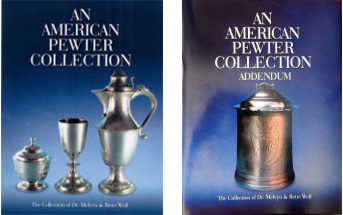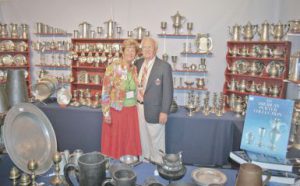An American Pewter Collection
By Dr. Melvyn and Bette Wolf
$150.00 – Original
$65.00 – Addendum

Book Review, by Dean F. Failey
An American Pewter Collection: The Collection of Dr. Melvyn & Bette Wolf published by the Wolfs in April 2006. ISBN 0-9779052-0-9. Leather-bound hardcover book, 474 pages, 584 black and white photographs, plus 29 in color. Price is $150 plus $8 shipping charges and may be ordered from the authors: Dr. Melvyn & Bette Wolf, 1196 Shady Hill Court, Flint, MI 48532-2362.
Let there be no doubt about it, An American Pewter Collection: The Collection of Dr. Melvyn & Bette Wolf, is a remarkable and important addition to the pewter bibliography and it is specifically intended for collectors, although curators and academics will find it useful as well. This is a book written by two of the most passionate collectors you will ever meet. One might call this a wish book, as in, “I wish this was my collection!” It is not a history of American pewter nor is it about the craft of pewter making or the pewterer’s themselves. In the introduction to the book, Bette and Mel state, “We feel that the primary function of this catalogue will be to allow the reader to compare forms and marks in their own collection with ours.” Essentially, this weighty tome (approximately 6 ½ lbs.) is a collector’s guide and is purposefully organized to provide a quick and easy reference source for the collector. It is also a documentation of the largest and most comprehensive collection of American pewter ever assembled and reason enough to make sure this book is on your library shelf. Just as a brief example of the depth and range of this collection, there are 37 tankard entries, 20 flagons and 89 porringers.
 The catalogue is organized alphabetically by form and within each section the entries are again listed alphabetically by pewterer. Each section is preceded by a listing of the pewterers and the figure numbers for their entries. Each entry provides the standard basic information: name of maker, working dates, acquisition date, provenance, brief description and measurements, mark description, publication references and comments. All pieces are illustrated together with their touch marks with the exception of basins, dishes and plates where only the marks are illustrated. Marks are also referenced to Carl Jacobs, Guide to American Pewter, and occasionally to Ledlie Laughlin’s, Pewter in America. Importantly the photographs of both the objects and their marks are large and readable.
The catalogue is organized alphabetically by form and within each section the entries are again listed alphabetically by pewterer. Each section is preceded by a listing of the pewterers and the figure numbers for their entries. Each entry provides the standard basic information: name of maker, working dates, acquisition date, provenance, brief description and measurements, mark description, publication references and comments. All pieces are illustrated together with their touch marks with the exception of basins, dishes and plates where only the marks are illustrated. Marks are also referenced to Carl Jacobs, Guide to American Pewter, and occasionally to Ledlie Laughlin’s, Pewter in America. Importantly the photographs of both the objects and their marks are large and readable.
 Anyone who has heard Bette or Mel give a presentation or lead a discussion at a Pewter Collector’s Club meeting knows the enthusiasm and humor that they inevitably convey along with their incredible knowledge gleaned from forty years of collecting and handling pewter. I am glad to say that traces of both appear in the “comments” portion of the individual entries. The comments read as though Mel or Bette were standing next to you while examining a piece of pewter. Referring to a dish by Jacob Whitmore, the comments read, “Whitmore’s strike tends to be quite weak. This is one when he had his Wheaties.” For a Richard Lee porringer, Mel writes, “Birthday present from my wife.” The comments are short and at first glance I thought too brief, but upon reflection I realized they provided pithy and useful information that a collector could really use. For example, the comments on a pair of Roswell Gleason chalices states, “While Gleason chalices are never found marked, they accompany many signed flagons and communion plates allowing for strong attribution.” More esoteric, but typical, is the comment on a William Will sugar bowl, “William Will used two different lids in the same base casting, one lid was inset and the other was overlapping.” And did you know there are only three hammered American basins known (all in the Wolf collection)? Other than the PCCA Bulletins, you won’t find such helpful nuggets anywhere else folks!
Anyone who has heard Bette or Mel give a presentation or lead a discussion at a Pewter Collector’s Club meeting knows the enthusiasm and humor that they inevitably convey along with their incredible knowledge gleaned from forty years of collecting and handling pewter. I am glad to say that traces of both appear in the “comments” portion of the individual entries. The comments read as though Mel or Bette were standing next to you while examining a piece of pewter. Referring to a dish by Jacob Whitmore, the comments read, “Whitmore’s strike tends to be quite weak. This is one when he had his Wheaties.” For a Richard Lee porringer, Mel writes, “Birthday present from my wife.” The comments are short and at first glance I thought too brief, but upon reflection I realized they provided pithy and useful information that a collector could really use. For example, the comments on a pair of Roswell Gleason chalices states, “While Gleason chalices are never found marked, they accompany many signed flagons and communion plates allowing for strong attribution.” More esoteric, but typical, is the comment on a William Will sugar bowl, “William Will used two different lids in the same base casting, one lid was inset and the other was overlapping.” And did you know there are only three hammered American basins known (all in the Wolf collection)? Other than the PCCA Bulletins, you won’t find such helpful nuggets anywhere else folks!
The somewhat autobiographical introduction is an enjoyable read filled with tips on collecting and insight on the Wolf’s approach to forming a collection. Here they also state their intention not to repeat information that appears in previous books. The only problem is that they know more about American pewter than most of us will forget and now and again we are left slightly befuddled. The entry on a porringer, figure 590, gives the maker as John Skinner of Boston. The comments, however, state that some authorities don’t believe Skinner used that mark and that it may have been made by Thomas Green. Thomas who? If you look at entry 401, a mug identified as by John Skinner, which has the same mark as porringer 590, there is no reference to the questionable mark or the possibility it was made by another Boston maker. The answer to the riddle is to note the publication reference in the porringer entry, which refers to an article by Dr. Wolf in a PCCA Bulletin on flower-handled porringers. The Wolf’s, have in fact, authored over 90 articles for the PCCA Bulletin, and you’re just going to have to go back and read all of them! Conveniently, a complete list of their articles is included in an appendix.
Yes, I wish there had been comparative group photographs of regional tankards, mugs, and porringers together, or a sequence of stylistic forms together, but what the heck, this is their collection and they did it their way. From personal experience, I know how difficult it is to formulate and write a book. Few are perfect. But if you have an interest in American pewter, this book is a treasure and one you must own!


